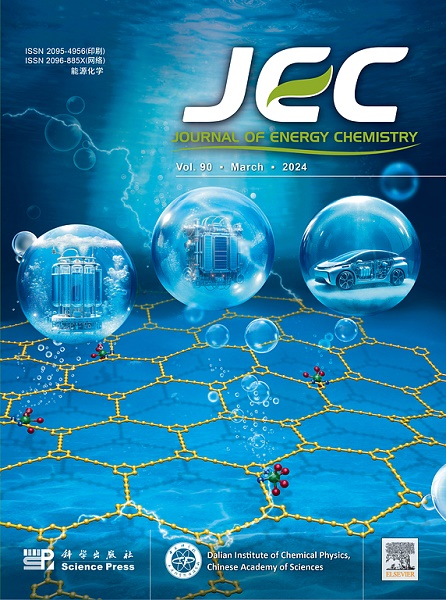Importance of passivation efficiency of the passivator for efficient printable mesoscopic perovskite solar cells
IF 13.1
1区 化学
Q1 Energy
引用次数: 0
Abstract
The stacking of multiple defect-rich grain boundaries (GBs) along the long transportation path (∼3 μm) of charge carriers in printable mesoscopic perovskite solar cells (p-MPSCs) impedes their power conversion efficiency (PCE). Organic Lewis bases are widely utilized for defect passivation at GBs, but how their passivation efficiency affects energy loss remains unclear. Here we employed triphenylphosphine (TPP) and triphenylphosphine oxide (TPPO) as the model passivators in p-MPSCs. TPPO has a more negatively charged center than TPP, which enables its stronger coordination with one of the most common and detrimental defects at the GBs—undercoordinated lead. When added into the perovskite with the same ratio, TPPO passivates defects more significantly and thus less TPPO remaining inactive compared with TPP. Inactive organic passivators accumulated at the GBs could impose barriers to charge carrier transportation. Indeed, TPPO improves the device performance more significantly with a champion PCE of 20.54% achieved. Besides, the TPPO devices demonstrate excellent stability with 95% of initial PCE remaining after 600 h of maximum power point tracking at (55 ± 5)°C.

钝化剂的钝化效率对高效可印刷介观钙钛矿太阳能电池的重要性
在可打印介孔钙钛矿太阳能电池(p-MPSCs)中,沿电荷载流子长输运路径(~ 3 μm)上多个富缺陷晶界(GBs)的堆积阻碍了它们的功率转换效率(PCE)。有机路易斯碱被广泛用于锗酸镓的缺陷钝化,但其钝化效率如何影响能量损失尚不清楚。本研究采用三苯基膦(TPP)和三苯基膦氧化物(TPPO)作为p-MPSCs的模型钝化剂。TPPO的中心负电荷比TPP更大,这使其能够更好地协调gbs -不协调领导中最常见和最有害的缺陷之一。与TPP相比,在钙钛矿中以相同比例加入TPPO时,TPPO对缺陷的钝化作用更明显,因此TPPO的失活率更低。无活性有机钝化剂积累在GBs可能会对电荷载流子的运输造成障碍。事实上,TPPO更显著地提高了设备性能,PCE达到了20.54%的冠军水平。此外,TPPO器件表现出优异的稳定性,在(55±5)°C下最大功率点跟踪600小时后,初始PCE仍保持95%。
本文章由计算机程序翻译,如有差异,请以英文原文为准。
求助全文
约1分钟内获得全文
求助全文
来源期刊

Journal of Energy Chemistry
CHEMISTRY, APPLIED-CHEMISTRY, PHYSICAL
CiteScore
19.10
自引率
8.40%
发文量
3631
审稿时长
15 days
期刊介绍:
The Journal of Energy Chemistry, the official publication of Science Press and the Dalian Institute of Chemical Physics, Chinese Academy of Sciences, serves as a platform for reporting creative research and innovative applications in energy chemistry. It mainly reports on creative researches and innovative applications of chemical conversions of fossil energy, carbon dioxide, electrochemical energy and hydrogen energy, as well as the conversions of biomass and solar energy related with chemical issues to promote academic exchanges in the field of energy chemistry and to accelerate the exploration, research and development of energy science and technologies.
This journal focuses on original research papers covering various topics within energy chemistry worldwide, including:
Optimized utilization of fossil energy
Hydrogen energy
Conversion and storage of electrochemical energy
Capture, storage, and chemical conversion of carbon dioxide
Materials and nanotechnologies for energy conversion and storage
Chemistry in biomass conversion
Chemistry in the utilization of solar energy
 求助内容:
求助内容: 应助结果提醒方式:
应助结果提醒方式:


